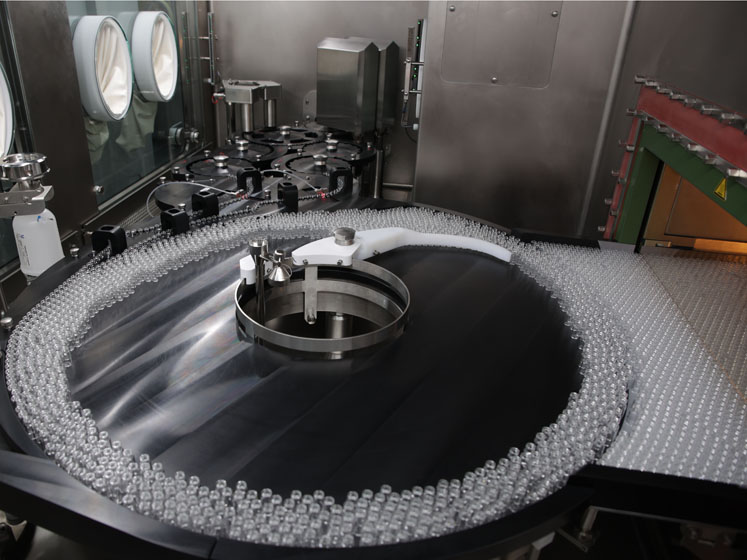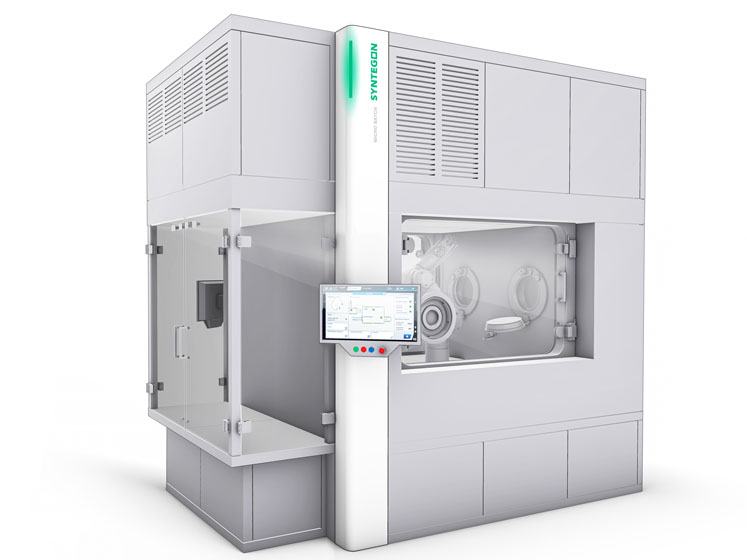Visual inline inspection technology counteracts this situation. Integrated cameras and sensors monitor and document every step of the process — from empty vial inspection to the print verification of filled vials.
Reliability is key in fill-finish processes. It not only involves manufacturing high-value products according to the most stringent quality standards, but also doing it economically. The production of liquid pharmaceuticals, including highly specialised biotech drugs for small patient groups, is a cost-intensive task. As such, pharmaceutical manufacturers must reduce product loss to a minimum.
Visual inline inspection technology, which is directly integrated into the production process, plays an important role in terms of helping manufacturers to proactively reduce rejects.
Increased quality thanks to pre-emptive inline inspection
According to GMP Annex 1, pharmaceutical manufacturers and contract manufacturing organisations (CMOs) must subject filled vials to a stopper seat verification step prior to crimping. The goal is to prevent microbiological contamination and to ensure product quality.
Many manufacturers add further inline inspection steps to this mandatory procedure. They enable them to intervene in the capping process at an early stage (if necessary).
This precaution makes perfect sense: once the drug has been filled into the container, the vials can only be sorted out at the end of the manufacturing process — even if the inspection systems identify them as faulty beforehand.

This might lead to financial losses and a waste of resources. Moreover, CMOs and pharmaceutical manufacturers may not be able to determine which processing step caused the defect.
Inline inspection technologies check empty vials, the stopper’s seat, crimp quality, cap roundness and pressure, and continuously monitor the quality of both the filling process and the packaging materials. They also detect deviations from defined standards and provide data for subsequent process optimisation. The centrepiece of these systems comprises special cameras or optical sensors and precisely matched lighting.
First step: empty vial inspection
A key link in the chain to reduce product loss can be found right at the beginning of the process when cameras check the integrity of the empty containers before filling. They inspect the opening, base and side walls of the vials for foreign bodies — such as glass fragments or impurities — to rule out contamination.
They also examine the integrity of the vial itself, which should not show any chipping or cosmetic defects such as scratches or cracks. Defective vials are marked as faulty and rejected. This inspection step prior to filling plays an important role, especially for lyophilised drugs, as foreign bodies such as splinters or impurities in the product are much more difficult to identify after freeze drying.
Inspecting sealed vials
Good vials are filled and fitted with a stopper in the next process step. Visual inspection systems then check the stopper presence and positioning; that is, whether the stoppers are positioned at an angle inside the vial or are missing altogether.

In the next step, cameras thoroughly check the crimping process. They take images of the containers to detect cosmetic defects or crimping errors, as well as missing or uncrimped caps. Even before the caps are applied to the vial, faulty caps can be sorted out thanks to integrity checks.
Subsequent rejection, for example owing to deformation or incorrect colour, should be prevented … even more so in the case of high-priced drugs.
Visual inspection systems can also be used for print verification of the container, cap or label. If required, they perform a presence and quality check of the coding number. This data allows manufacturers to draw conclusions about the drug itself, the manufacturing company and the batch number, and serves to improve traceability.
Data is the key to better quality
Inline inspection also offers other advantages; should process discrepancies occur, it allows manufacturers to perform data-supported troubleshooting. The second the system identifies a process error, it documents the corresponding time window, batch number and production parameters.
Operators can use this inspection data (stored in the HMI) to determine where the error occurred during the fill-finish process. They can also rectify them quickly, knowing whether it was a single incident or a chain of irregularities.
This not only ensures significantly lower downtimes and less product loss, it also makes a decisive contribution to increasing the overall equipment effectiveness (OEE) and profitability of production.
In addition, data-based inline inspection supports the requirement for consistent documentation, especially for GMP-relevant interventions. If, for example, a glove intervention is mandatory in the sterile process, operators can document this via digital images.

In the event of legal claims, this documentation can prevent pharmaceutical companies from completely discarding affected batches. The data enables the creation of digital protocols that document the complete audit trail of production. This evidence is a crucial prerequisite to validate the filling line and to receive market approval for the filled drug.
Inline and end-of-line: it’s the combination that counts
Experienced partners such as Syntegon have been helping pharmaceutical manufacturers to source application-specific solutions for many years — for both existing and new filling lines. The Versynta microBatch is a good example: this flexible platform, designed for small batches, inspects the entire filling process via cameras and co-ordinates packaging supply and processing. Defective containers are sorted out during the filling process.
In addition, Syntegon also offers the mandatory end-of-line inspection equipment. Innovative and high-precision technologies identify cosmetic and attributive defects as well as visible particles in liquids, lyophilised solutions or powders in syringes, vials, cartridges or ampoules.
Thanks to many years of inspection experience, the company’s broad portfolio includes state-of-the-art visual inspection technologies for fully automated processes as well as semiautomated and manual solutions.
With a sophisticated combination of inline and end-of-line inspection plant, pharmaceutical manufacturers are approaching zero-defect production, which minimises the loss of costly drugs and ensures maximum product safety.
